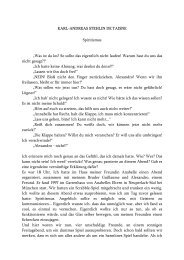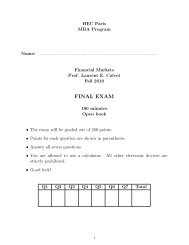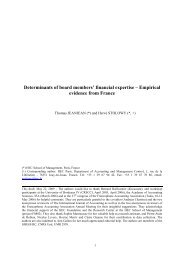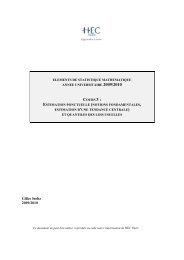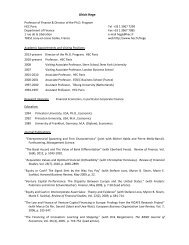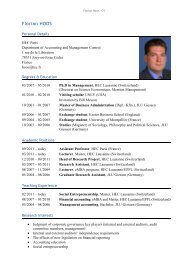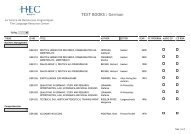Multifractality of US Dollar/Deutsche Mark Exchange Rates - Studies2
Multifractality of US Dollar/Deutsche Mark Exchange Rates - Studies2
Multifractality of US Dollar/Deutsche Mark Exchange Rates - Studies2
Create successful ePaper yourself
Turn your PDF publications into a flip-book with our unique Google optimized e-Paper software.
• α0 denotes the value <strong>of</strong> α for which f(α0) = 1. This is the maximum value <strong>of</strong> the multifractal<br />
spectrum. By strict concavity, α0 is unique. This is also the most frequently occurring value<br />
<strong>of</strong> α, occupying a set <strong>of</strong> Lebesgue measure one (or T if the sample span is not renormalized<br />
to a value <strong>of</strong> one.)<br />
• α1 denotes the value <strong>of</strong> α that carries most <strong>of</strong> the mass <strong>of</strong> a multifractal measure, or most<br />
<strong>of</strong> the variation <strong>of</strong> a multifractal process. Multifractal measures satisfy f(α1) =α1. The<br />
spectrum <strong>of</strong> a multifractal process generated by the MMAR thus satisfies fP (α1) =1/H.<br />
• αmin denotes the smallest manifest α, i.e. αmin =<br />
• αmax denotes the largest manifest α.<br />
<br />
<br />
min : f(α) ≥ 0 .<br />
α<br />
Each <strong>of</strong> these points is depicted in the multifractal diagram shown in Figure 8.<br />
4.4 Unifractal Examples<br />
While the Legendre transform (8) can be worked out mechanically, a graphical representation is<br />
more instructive. This is obtained by plotting, for each q, a line <strong>of</strong> slope q and vertical intercept<br />
−τ(q). Placing all <strong>of</strong> these lines upon the same graph, the lower envelope gives the estimated<br />
multifractal spectrum.<br />
For each <strong>of</strong> the Fractional Gaussian Noises in Figure 4, the simulated partition functions follow<br />
lines <strong>of</strong> approximate slope τ(q) =Hq − 1. Figure 9 shows Legendre transforms <strong>of</strong> scaling functions<br />
for FGN’s with self–affinity indices .4, .53, .6, .8. Only the left side <strong>of</strong> each spectrum is shown.<br />
The right side <strong>of</strong> the multifractal spectrum comes from negative moments <strong>of</strong> the partition function,<br />
which are not used in the empirical work in this paper. Each <strong>of</strong> the lines drawn passes through the<br />
same point at {α, f(α)} = {H, 1} . The lower envelope is thus degenerate:<br />
⎧<br />
⎪⎨ 1, α = H<br />
f(α) =<br />
⎪⎩ −∞, α = H<br />
By inspection <strong>of</strong> equation (8), this form derives from the linearity <strong>of</strong> τ(q). The multifractal spectrum<br />
is defined only for values <strong>of</strong> α that are tangency slopes for some value <strong>of</strong> the scaling function.<br />
A single valued multifractal spectrum is an alternative way <strong>of</strong> saying that each <strong>of</strong> these processes<br />
contains only a single Hölder exponent. Thus α0, which carries all <strong>of</strong> the Lebesgue measure <strong>of</strong> the<br />
17



